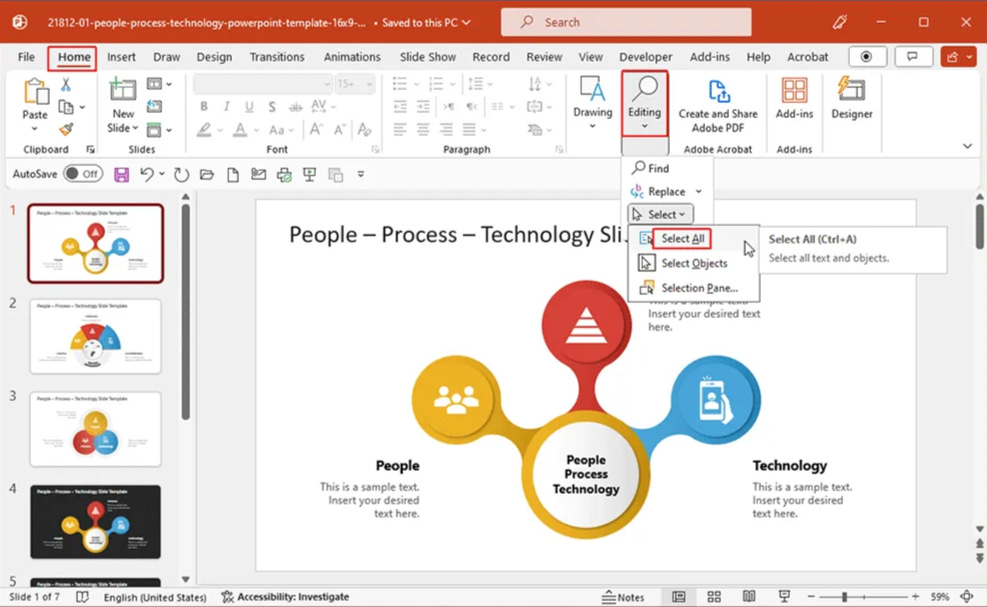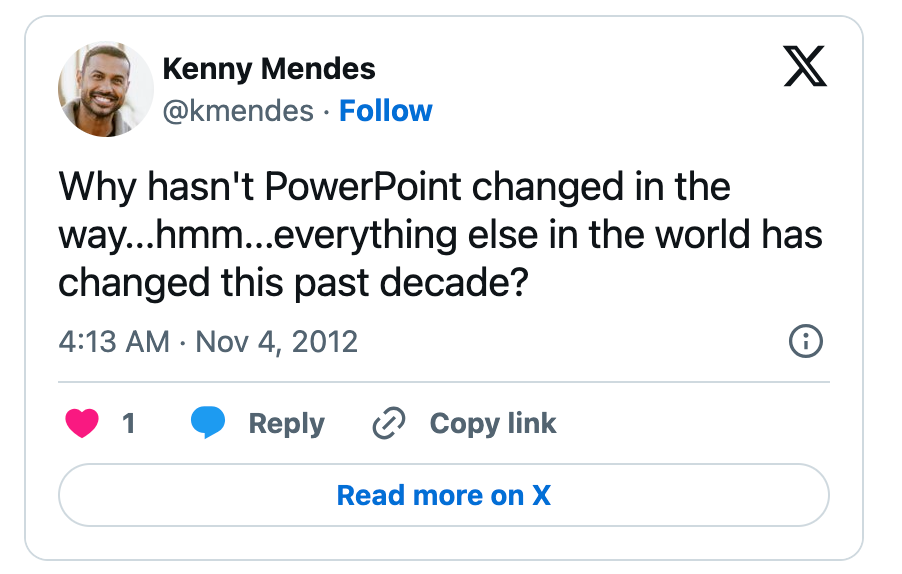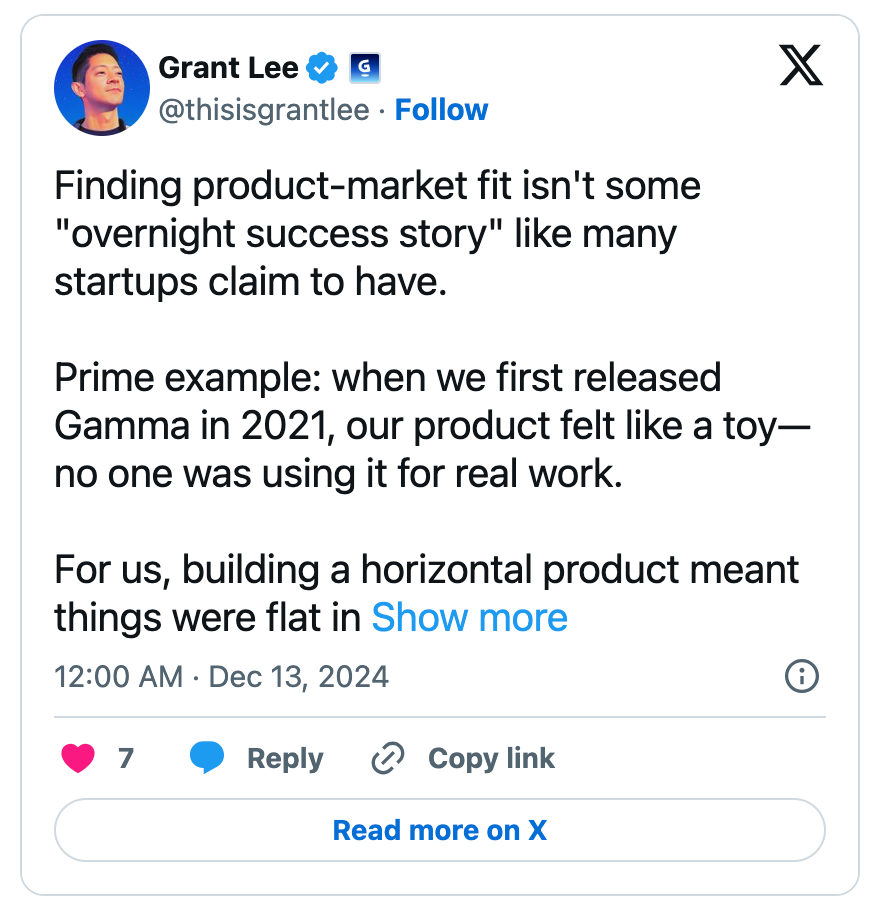Gamma’s rise to 50 million users
How they got there with a lean team of 35 and $20M+ in funding.
Gamma just hit a huge milestone: 50 million users.
Pretty wild when you think about what they’re building. Gamma is neither a mass-market consumer play, nor viral AI toy, nor enterprise SaaS.
It’s… an AI-powered way to make decks, websites and docs.
Really it’s a productivity tool, aimed at people – knowledge workers, founders, startup teams, educators etc. – who makes slides, share structured ideas, and present things.
It’s horizontal enough to grow big, but not so universal that everyone and their nan is using it to share photos.
It sits in this sort of grey area, straddling the middle lane, which for many tech tools would be their downfall. But it’s a huge part of the reason for Gamma’s success, and makes their new milestone all the more impressive.
Keep reading to hear first-hand from Gamma’s founder, Grant Lee, how they achieved this rapid growth, and the things we can learn from their journey.
Hey 👋 Ben’s Bites is a twice-weekly newsletter about startups and investing – for AI builders of all levels. Subscribe to join 120,000+ readers and get posts like this straight to your inbox.
Slides don’t suck anymore, yay!
I first came across Gamma around 18 months ago after Ben angel invested (more on that below).
I remember thinking how not awful it felt to use. No fiddly formatting or anaemic-looking slides or decision paralysis about whether to use bullet points or paragraphs of text. Just type a prompt or upload a document, et voilà – a near-perfect, beautiful slide deck or website appears before your very eyes.
It’s not magic, but it certainly feels like it!


Many of us millennials (and older) have a somewhat haunted relationship with slide decks.
A quick archive search on X confirms this:
The BBC even published an article back in 2015 titled How to avoid 'death by PowerPoint', lol.
The Gamma team saw everyone’s pain and stepped in to relieve us. The slide deck Tylenol we never knew we needed.
Finding that spark: How it all began
Gamma was founded in 2020 by Grant Lee, Jon Noronha and James Fox, who’d all previously worked together at Optimizely.
At a time when the world was going remote and people were sharing online more than ever, the founders saw a gap. Presentation tools were broken, especially when it came to speed and ease. You know the feeling – you have an idea you need to share quickly ideally with some structure and polish, but not enough time to make it look good. You want it to feel like a deck without needing to actually build one.
So Gamma started as an attempt to reimagine that workflow, to make it faster and less painful to turn messy thoughts into something that looked polished enough to ship.
It launched on Product Hunt in 2022 with some fanfare. I actually went back to look at the launch page – nothing flashy or any wild claims, just a clean UI and the promise of “a fast, simple way to share and present your work.”
Backing the vision early
After Gamma’s quiet launch, they raised a seed round in late 2021 led by Accel, with participation from the founders of Airtable, Patreon, Segment, and Honey, plus folks like Eric Yuan (Zoom) and Julie Zhou (ex-Facebook).
In early 2023, as Gamma’s AI-powered workflow started gaining serious traction — reportedly around 10k new users a day — they opened up a small allocation for angel investors. Ben was scouting for Andreessen Horowitz at the time while also raising his own fund.
“A friend at First Round told me Gamma had opened up a small allocation for angel investors. I registered my interest, but didn’t hear anything back. I really wanted in on this deal and thought, screw it, I’m just going straight to them. I reached out to Jon directly, set up a call, and a cheque closed soon after.”
– Ben Tossell
That investment closed during a seed extension in May 2023 — a quiet internal top-up before Gamma went on to raise a $12M Series A, again led by Accel, in May 2024.
Gamma has raised around $19M total to date. For a company now serving more than 50 million users, it’s an impressive and lean trajectory by SaaS standards.
Grant, Jon and James have clearly paced their funding deliberately. They kept their burn low (under 30 people even after the Series A) and timed their bigger raise for when they’d actually found the unlock (see “The inflection point” below).
It’s a nice counterpoint to the usual raise-fast-grow-fast model. Like a quiet confidence that they were building the right thing and just needed time for the product to catch up with the vision.
Building for product > hype
Though the early version of Gamma was neat, slick and different, it felt more like a curiosity than a must-have. A bit toy-like, in Grant’s words. People liked playing with it, but not many were using it for “real work.”
Which makes sense. When you're building something horizontal – not tied to a single use case – it can be hard to get traction early. There’s no obvious first user. You end up testing and retesting basic building blocks, hoping someone finds a workflow that sticks.
By the way, founder Grant writes great atomic essays on X. Like this one which explains the problem with (and a solution to) building horizontal products:
By the time the team launched on Product Hunt and opened up a public beta, there were stronger signals. More people were using Gamma. But still, it hadn’t quite crossed into “tell your friends” territory.
That came next. And the unlock was AI – not as an add-on, but as the thing that redefined the whole product.
The inflection point: AI as the core workflow
The Gamma team started experimenting with AI in the latter half of 2022. But not “let’s add an AI button” and more “what happens if we make AI the entry point for the entire experience?”
“We completely revamped our onboarding flow with AI creation at its core,” Grant says.
“The feedback was immediate and clear: "This is incredible — it has to be core to the product." When we made AI central to the entire experience, users didn't just try it once… …they made it part of their workflow. That's when we knew we found product-market fit.”
“It took us 8 months to get to 60,000 signups (pre-AI). And less than a week to add the next 60,000 signups after our AI launch.”
– Grant Lee
After integrating AI, organic growth picked up, word-of-mouth took off, and retention curves looked healthier across the board.
Wild.
What makes Gamma so damn sticky
Gamma has really made its mark as the go-to tool for modern presentations and pages. But why? I want to dig into why Gamma has stuck (and continues to grow).
For starters, it’s genuinely a nice product to use.
It feels intuitive and light. The UI is there for you, yet also kinda gets out of the way. You just type and watch something impressive take shape. It’s almost as if the founders said, “how can we help people get to where they need to be as quickly and as easily as possible?” and then really followed through on that.
It also hits a sweet spot.
It’s powerful enough for serious work like pitching, documenting and teaching, but simple enough that people aren’t afraid to just jump in and try things. It’s broad, but not vague (again, nailing that middle lane beautifully).
It does a better job of an existing product.
A trap many founders fall into is trying to build a product that reinvents the wheel. “"Build things people want" is dangerously incomplete business advice,” Grant warns. He says that “Building things people are ALREADY buying” is the key, “– just build them better.” Needless to say this is exactly what Gamma does.
It replaces multiple things at once.
Instead of writing in Docs, designing in Slides, and then copy-pasting into Notion or Webflow, you can just build the thing in Gamma and hit publish.
Where does it go from here?
Gamma’s hit 50 million users with a team of just 35 people and relatively modest funding. That’s rare. And it raises the obvious question: what now?
They could…
Stay lean and keep doubling down on product – Adding polish, improving workflows, refining the AI layer etc.
Start pushing into more structured use cases: team plans, education, maybe even enterprise.
It wouldn’t be surprising to see them evolve into a more collaborative platform over time, especially as remote teams look for lightweight ways to share work beyond yet another Google Doc.
But growth brings pressure. As the user base diversifies, so do the expectations. People want different features, different levels of control, maybe even integrations into the ecosystem they already work in. The tricky part will be expanding without losing the clarity and focus that made Gamma feel great to begin with.
For other builders, Gamma’s story is worth watching, not because they jumped on an AI trend but because they didn’t. They made AI useful but invisible – central to the workflow rather than a shiny toy.
Maybe that’s probably the bigger takeaway here, that the best product experiences aren’t always the ones shouting the loudest. They’re the ones that quietly make something hard feel easy, and earn their spot in your daily toolkit because of it.
Written by Shanice.









